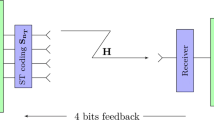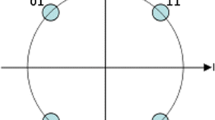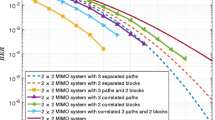Abstract
In this paper we consider the utilization of multiple transmitterand receiver antennas for space-time diversity. The optimalSNR scheme, which also provides the best diversity, is outlined.This scheme however involves a reduction in the data rate. Coding schemes are then presentedwhich not only achieve the optimal SNR but also mitigate the reductionof data rate. The proposed schemes are based on the theory of Orthogonal Designsand Amicable Orthogonal Designs.
Similar content being viewed by others
References
S.A. Alamouti, “A Simple Transmit Diversity Technique for Wireless Communication”, IEEE J. on Select Areas in Comm., Vol. 16, pp. 1451–1458, 1998.
G. Ganesan and P. Stoica, “Space-Time Block Codes: A Maximum SNR Approach”, IEEE Trans. on Info.Theory, submitted.
G. Ganesan and P. Stoica, “Space-Time Diversity”, in G. Giannakis, Y. Hua, P. Stoica, and L. Tong (eds.), Signal Processing Advances in Communication, Prentice Hall: New York, 2000, to be published.
A.V. Geramita and J. Seberry, Orthogonal Designs, Quadratic Forms and Hadamard Matrices, Lecture Notes in Pure and Applied Mathematics, Vol. 43, Marcel Dekker: New York and Basel, 1979.
W.C. Jakes, Microwave Mobile Communications, John Wiley: New York, 1974.
Y. Kawada and N. Iwahori, “On the Structure and Representation of Clifford Algebras”, Journal ofMathematical Society of Japan, Vol. 2, pp. 34–43, 1950.
A.J. Paulraj and C.B. Papadias, “Space-Time Processing for Wireless Communications”, IEEE Signal Proc.Magazine, pp. 49–83, 1997.
J.G. Proakis, Digital Communications, McGraw-Hill: New York, 1989.
J. Radon, “Lineare scharen orthogonaler Matrizen”, Abhandlungen aus dem Mathematischen Seminar der Hamburgishen Universitat, Vol. 1, pp. 1–14, 1922.
P. Stoica, G. Ganesan and A. Paulraj, “Space-Time Processing for Wireless Communications”, in Proceedings of ICICS'99, Singapore, December 1999.
V. Tarokh, H. Jafarkhani and A.R. Calderbank, “Space-Time Block Codes from Orthogonal Designs”, IEEE Trans. on Info. Theory, Vol. 45, pp. 1456–1467, 1999.
Author information
Authors and Affiliations
Rights and permissions
About this article
Cite this article
Ganesan, G., Stoica, P. Space-Time Diversity Using Orthogonal and Amicable Orthogonal Designs. Wireless Personal Communications 18, 165–178 (2001). https://doi.org/10.1023/A:1011290310428
Issue Date:
DOI: https://doi.org/10.1023/A:1011290310428




